Claudia Weill’s Girlfriends (1978) follows the friendship of Susan and Anne, who struggle to navigate the changes to their previously homoromantic dynamic, after Anne’s marriage. This sequence presents a conflict between the two, that can be heavily linked to their respective relationships to their gender expression, and the restrictive nature of imposed gender ideologies in the 1970s that are still relevant today.
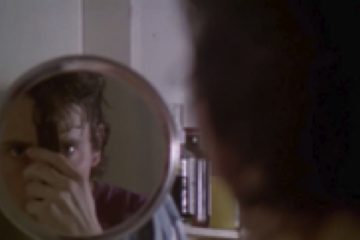

The first shot of Susan’s boyfriend Eric, is a close-up of him prodding strands of his hair with a comb, looking into a mirror (Figure 1). Meanwhile, in a medium-long shot, Susan watches (Figure 2). This in itself is a contradiction to typical gender roles as have been laid out by hundreds of years of nude artwork, depicting women being watched by men, and setting out the rule that “men look at women [and] women watch themselves being looked at” (Berger, 1972). Here, a new, modern kind of masculinity is presented in conjunction with more traditional masculinity; Eric’s desire to watch a football game instead of spending time with Susan. This traditional ideology of women being something to be looked at can also be read in the nude art piece in the foreground of the frame (Figure 2), the figure of which bears a strong resemblance to Susan, and may be a self-portrait. This piece being placed directly adjacent to Eric within the frame, presents the complexities with which gender ideologies can coexist and contradict each other, and with which gender roles and the male gaze play a part in Susan’s life as a girlfriend and a female artist.
The shot of the couple through the doorway (Figure 2) mimics a box, as if they feel pressure to conform to the expectations of their respective genders, while also wishing to break free from those expectations. Susan with her desire for a career in photography, and her possibly repressed bisexuality, which can be read through the queer-coded moments throughout the film, such as Susan photographing a sleeping Anne in the opening scene, and Susan’s new roommate implying her sexual attraction towards her. And Eric’s insecurity surrounding his masculinity in comparison to others, such as Martin and his “three-piece suit.” This comment is somewhat reinforced but mostly subverted by Martin’s preppy sweater vest (Figure 3). Then again, Martin is arguably much more stable than Eric, spending his day off looking after his child and with plans of a dinner party, as opposed to Eric’s blowing off said party to watch a sports game. However, returning to Martin’s costume, he is still a far cry from Eric’s image of him. This suggests that Eric’s insecurities lie, not within a real intimidation by Martin, but within a wider pressure from societal teachings of gender, linking to Judith Butler’s theory that gender is a performance of taught behaviours (519-20).
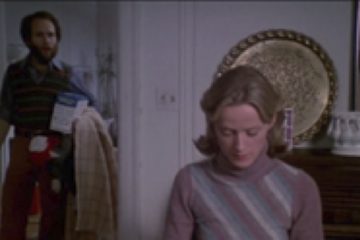
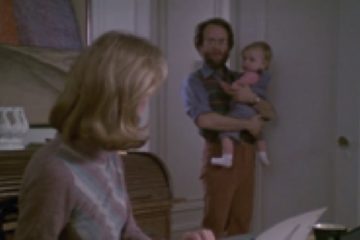
One might argue that traditional gender roles are switched between Anne and Martin, as Anne sits at her typewriter, and Martin holds an armful of children’s products (Figure 3), and sees to their crying baby (Figure 4). The wide panning shot of Martin disappearing and reappearing in the hallway behind Anne displays her prioritisation of her writing over her husband and child, and Martin’s apprehension to disturb her. This reversal is presented to have produced a bitter wife, wrongfully scolding her domestic husband, while in a reversed situation, this would likely be interpreted as a typical, working father, and stay-at-home mother dynamic, presenting the double-standards of gender within parenting. Contextually, perhaps this scene can be read differently, or at least, on a deeper level. Martin asks Anne the whereabouts of certain children’s products, suggesting he does not habitually tend to their child, and thus also suggesting that the rarity of Anne’s work-mode, in which she is dismissive of Martin, is another factor that heightens the tension between them.

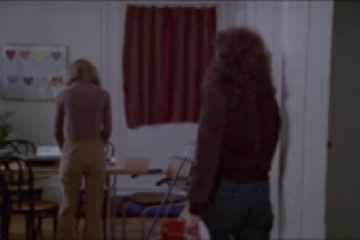
Ironically, the most prevalent gender conflict in this sequence, and throughout, is between Susan and Anne, who represent two opposing types of women, from different points of progression of the expectations of femininity in the late twentieth century. This can be read in the set dressing; the bow tie art piece on the wall next to Susan (Figure 5), and the love hearts piece in the subsequent shot (Figure 6). These are representative of the pair’s opposing paths in life: Susan’s of work, and Anne’s of family; and not only this, but the simultaneous presence of these two paths in one space or person, such as within Anne and her home. The bow tie’s connotations of masculinity, versus the hearts’ connotations of femininity also point to the irony of their associations, as here, they are both being associated with women, reinforcing the negative consequences of viewing gender, not as a performance of roles, but as a natural system; there’s nothing natural about a bow tie.
The fact that Susan views Anne as merely “married” and that Anne believes she “can’t stand it”, depicts their restrictive views around what it means to be a woman. This can also be associated with changing expectations of women, from the 1950s “wholesome, suburban” housewife, to the 1980s ideal woman who is “androgynous […] while hyper-highlighting her femininity” (Trafas). This links to Anne’s imposed identity as a housewife, and her compulsion to reduce Susan to a successful photographer with a boyfriend and too much time on her hands. This compulsion to hold other women to a certain standard of “womanhood” links to Judith Butler’s theory that people “come to believe” their taught gender expectations, and perform them “in the mode of belief” (520).

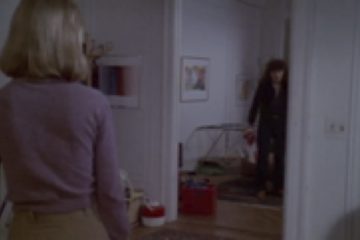

The blocking and set in Anne’s house represents the divide between Susan and Anne, Susan following Anne into the room (Figure 7), then crossing the hallway (Figure 8), shouting back at her through the open door that Anne “doesn’t know [her] at all anymore”. This technique is also used when Martin and the baby loom over Anne as she writes. This set up exposes Anne’s desire to be more independent than her current life allows her to be, and Martin’s inability in aiding this, which is established as her opposing desire to be a mother and wife, and a professional writer. Here, the set creates a space in which Martin can be semi-present (Figure 9), and in which the two women, who should be united by their experience of gender, are victims of its restrictive nature.
In fact, the two women are going through very similar experiences. Anne’s jumper mimics Martin’s sweater vest, suggesting her desire to be a dominant, family figure like him, bringing in income, however its faded pink colour resembles a lack of passion and vitality, re-establishing this struggle between two sides of herself that, as a woman, she is being pressured to choose between; even by Susan who tells her that she “doesn’t have to work”. Meanwhile, Susan is struggling with her career, and her costume reflects Eric’s in a similar way, linking to the increasing desire in women to become professional like their male counterparts, and having to emphasise their masculinity to do so.
References
Berger, John. Ways of Seeing. Penguin, London: 1972.
Butler, Judith, (1988). “Performative Acts and Gender Constitution: An Essay in Phenomenology and Feminist Theory”. Theatre Journal, 40 (4), pp. 519–31.
Trafas, Marlena. “Femininity as Performance, and the Changing Face of Female Identity”. Lonewolfmag. Nd. Web. 23 May 2022

Jemima Kent is a first year Film student. They have a passion for queer rights, fashion history and writing, and hope to become a screenwriter or costume designer.
Please obtain permission before redistributing. Copyright © 2022 Jemima Kent